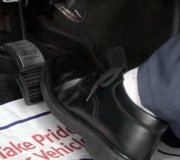GM has a valve assembly in their master cylinders that closes off a front and rear port when no pressure builds up in one of them, as in when there's a leak, or when pedal-bleeding.
The first thing to be aware of is if any car is over about one year old, never push the brake pedal all the way to the floor. Doing so will run the lip seals over the crud and corrosion that build up in the lower halves of the bores where they don't normally travel. The only bleeding method I ever use is gravity-bleeding. If someone else insists on pedal-bleeding, pretend there's a block of wood under the pedal and never push it more than half way down.
Besides not damaging the master cylinder, doing that will prevent tripping the valve in GM's master cylinders. When it's tripped, you'll find you can't get any brake fluid to flow from one front caliper and the opposite rear wheel cylinder. There's various bleeding sequences in the service manuals and other resources, and they often contradict each other, but I've found the order in which you bleed the brakes has no bearing on preventing that valve from tripping and blocking two ports. The secret is in not pushing the pedal more than half way to the floor, and to push it rather slowly.
Now that it's tripped, the only way I've found to reset it is to open the bleeder screw to the caliper that isn't flowing any fluid, then give it a short, quick burst of compressed air from a rubber-tipped air nozzle. Don't get carried away. You don't want to force air all the way back to the master cylinder and have to bleed that all out again. It just takes a tiny spurt to reset the valve, then let it gravity-bleed. Once all the wheels are done bleeding, close the bleeder screws, then "irritate" the brake pedal by hand a few times. As you work the pistons out of the calipers to adjust them, any little air bubbles still in there will wash into the calipers. Open each bleeder screw once more for a couple of seconds to let the last few bubbles pop out, and you're done.
If you get fluid to flow from all of the wheels but the brake pedal still goes down too far, suspect a lip seal was damaged by the previous bleeding attempts if the pedal was pushed all the way to the floor.
Monday, June 9th, 2014 AT 4:41 PM



